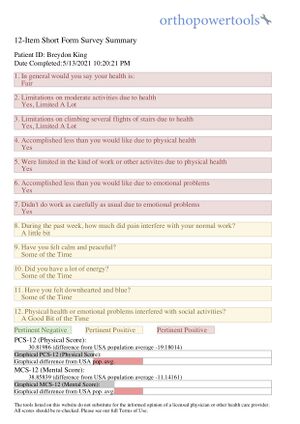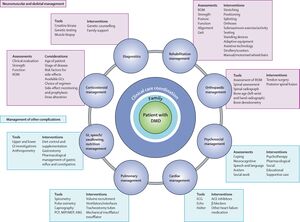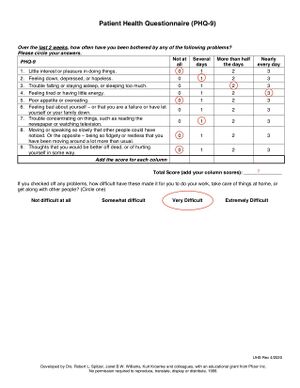Duchenne Muscular Dystrophy - Young Adult Case Study: Difference between revisions
No edit summary |
No edit summary |
||
| Line 260: | Line 260: | ||
|4/5 | |4/5 | ||
|} | |} | ||
'''Performance of the Upper Limb (PUL 2.0):''' | '''Performance of the Upper Limb (PUL 2.0):''' | ||
The PUL 2.0 was developed specifically for DMD and is capable of assessing a wide-spectrum of upper extremity function in both ambulant and non-ambulant individuals with DMD. The PUL was designed with a conceptual framework reflecting the progression of weakness and natural history of functional decline in the disease. This is a useful device for tracking disease progression and potential treatment efficacy, especially in non-ambulant patients such as Breydon. This measure addresses 3 domains of the UE: the high level shoulder, mid level elbow, and distal wrist and hand dimensions. A higher score indicates better UE functional ability, with a maximum total score of 42. | The PUL 2.0 was developed specifically for DMD and is capable of assessing a wide-spectrum of upper extremity function in both ambulant and non-ambulant individuals with DMD. The PUL was designed with a conceptual framework reflecting the progression of weakness and natural history of functional decline in the disease. This is a useful device for tracking disease progression and potential treatment efficacy, especially in non-ambulant patients such as Breydon. This measure addresses 3 domains of the UE: the high level shoulder, mid level elbow, and distal wrist and hand dimensions. A higher score indicates better UE functional ability, with a maximum total score of 42. | ||
Breydon scored a total of 18/42 on the PUL, a decrease of 7 points since last year when he scored 25/42, indicating a significant reduction in UE functioning. When comparing Breydon’s current score to non-ambulant DMD patients of similar ages, Breydon scored in the lower range, which further indicates that Breydon’s UE functioning is slightly lower than expected at point in the disease progression and has declined significantly over the past year. | Breydon scored a total of 18/42 on the PUL, a decrease of 7 points since last year when he scored 25/42, indicating a significant reduction in UE functioning. When comparing Breydon’s current score to non-ambulant DMD patients of similar ages, Breydon scored in the lower range, which further indicates that Breydon’s UE functioning is slightly lower than expected at point in the disease progression and has declined significantly over the past year. | ||
Revision as of 20:50, 14 May 2021
Abstract:
.
sdfds Introduction:
Duchenne Muscular Dystrophy(DMD) is an X-linked recessive disorder caused by mutations in the dystrophin gene. The mutation causes a defect in the synthesis of the protein dystrophin, resulting in progressive muscle degeneration. DMD has an incidence of about 1 in 3500 live male births. Most patients are diagnosed at approximately 5 years of age, when they lag behind their peers in physical abilities.
This disease results in progressive deterioration in limb and trunk strength, resulting in loss of independent ambulation by age 12. In milder forms of the disease such as intermediate muscular dystrophy and Becker muscular dystrophy, the process of degeneration is slow and loss of ambulation occurs at around age 16.
The genetic basis of DMD has been known for over 30 years and many encouraging therapeutic strategies have been developed. Advancements in corticosteroid, respiratory, cardiac, orthopedic, and rehabilitative interventions have led to improvements in function, quality of life, health, and longevity. Children diagnosed with DMD today have the possibility of living into their 40s. An interdisciplinary approach is critical for management of DMD in which the individual and family can access the expertise for the required multi-system. The interdisciplinary team would include a wide range of health-care professionals depending on local services, including (but not limited to) primary care Physicians, pediatricians, neurologists, physiotherapists and occupational therapists.
Client Characteristics:
Breydon King is an 18-year-old freshman studying Political Science at the University of Toronto. At five years of age he was diagnosed with DMD after his parents noticed multiple falls, difficulty going up a flight of stairs, and the inability to keep up with his teammates on the soccer field. At the age of twelve, Breydon became fully dependent on an electric wheelchair. Being mobile allows him to get around a lot easier and pursue his passions, such as participating in his weekly guitar club, and giving motivational speeches. He currently lives with his family near his university campus and receives help with his activities of daily living with a daily Personal Support Worker (PSW). With the added pressure from university, Breydon has reported feelings of anxiousness; he is feeling a lot more tired sitting for longer periods, and difficulty with fine finger movements while playing his guitar and typing notes on his computer after a short period of time. He states that he has been able to take notes using his speech to text dictation technology system since he attends lectures on zoom from home, but fears he will not be able to do so once classes return to in person in the fall.
Examination Findings:
Subjective:
History of Present Illness Breydon reports feeling tightness and loss of range of motion in both hands but more in his right wrist, hand and fingers starting 2 months ago, soon after he started university. He notices that he experiences more tightness in his index finger compared to other fingers. The discomfort has gotten progressively worse since then and lingers for longer periods of time. This stiffness not only affects his range of motion, but also limits his speed in typing, writing, playing guitar, and other daily tasks requiring fine motor movement of his hands. Increased tightness presents early in the morning and at the end of the day. Breydon has also been experiencing more than usual pain in the same areas of tightness. Braydon reports headaches in the morning and waking up several times during the night because of shortness of breath. He also reports increased shortness of breath when giving his biweekly motivational speeches at the elementary and high schools around his city. He experiences shortness of breath during the speech followed by increased fatigue for the rest of the day. Breydon expresses frustration and increased anxiety as these recent problems greatly interfere with his school life and extracurricular hobbies.
Past Medical History Breydon was diagnosed with scoliosis (left thoracic curve) 11 years ago, and was surgically treated to stabilize the spine. He reports feeling more of an imbalance between his left and right side each year. He was diagnosed with mild sleep apnea two years ago and currently uses a BiPAP machine to aid with breathing at night. Breydon was diagnosed with anxiety disorder 3 years ago, and occasionally experiences depressive symptoms. He underwent gastrectomy 3 years ago after several bouts of his flu became pneumonia.
Medications Fluoxetine (Prozac) - 40mg daily (anxiety management) Ibuprofen (Advil) - 200mg as needed, approx. once every 1-2 weeks (short-term pain relief) Emflaza (Deflazacourt) - 0.9mg/kg orally once per day (improve muscle strength and slow disease progression)
Current Interventions Breydon requires an assist of 1 to help with transfers to and from his wheelchair. He also requires assistance with eating, brushing his teeth, and with bathing. He currently receives this support at home from either his parents, older brother, and/or his PSW. He is unable to ambulate and uses an electric wheelchair for mobility. He utilizes a voice to text software when needed while completing school work on the computer.
Health Habits Breydon does not drink alcohol, smoke cigarettes or use recreational drugs.
Social History Breydon lives in a three bedroom condominium, with an elevator, on the tenth floor with his very supportive mother, father, and older brother. They also have a five year old Shih Tzu dog. His family has changed all the door knobs in the suite to lever-style handles. Breydon’s mother is a stay at home mom committed to helping Breydon get through his university degree. Prior to COVID-19, she drove him to his seminars and extracurriculars. His family prepares meals for him, and assists him with his activities of daily living. He also receives daily personal support assistance (PSW) from the Toronto Central LHIN twice a day for one hour each. His hobbies include learning to play the guitar at the community centre, bird watching, taking his dog out for walks down the valley, and public speaking at elementary schools/health seminars.
Current Functional History Breydon requires an assistance of 1 with both his basic and instrumental activities of daily living. As a child, Breydon’s upper extremity strength allowed him to perform independent anterior to posterior transfers, however due to decrease in U/E strength he is also dependent on an assist with transfers. He is unable to stand even on smooth surfaces, therefore is fully dependent on an electric wheelchair for mobility.Breydon’s last wheelchair assessment was conducted 3 years ago.
Family History No known family history of DMD. Breydon’s father has chronic hypertension and mother has asthma.
Chief Concern Breydon would like to complete his schoolwork (typing, writing) and play guitar at the same speed and with minimal error, like he used to be able to. He would like to complete daily fine motor tasks without the feeling of pain and discomfort.
Patient Self Reported Measures:
The Patient Health Questionnaire (PHQ-9): The Patient Health Questionnaire (PHQ-9) is a useful tool for assessing mental health and quality of life in DMD patients, specifically in the adult population. This questionnaire consists of 9 questions each are scored from 0-3, for a total score out of 27. These questions were taken from a longer version of the questionnaire and condensed into this self-administered version. The higher a patient’s score, the greater their depression severity, which has been shown to correlate with decreased functional status and increased symptom-related issues in life.
12- Item Short Form Survey (SF12): The SF-12 is a self-reported outcome measure assessing the impact of health on an individual's everyday life. It is often used as a quality of life measure. Two summary scores are reported from the SF-12 – a mental component score (MCS-12) and a physical component score (PCS-12). The scores are reported as Z-scores. The United States population average PCS-12 and MCS-12 are both 50 points and the standard deviation is 10 points.
Compared to the US population Breydon scored about 2 standard deviations below the average for physical component score and about 1 standard deviation below the average for mental component score. Detailed version of the patient’s SF-12 is attached below. The score on the PCS-12 is consistent with his functional dependence and the score on MCS12 is indicative of the decline in his mental health.

Objective:
Postural Analysis Breydon sits in a wheelchair with increased thoracic kyphosis. He leans towards his right side - likely due to his left thoracic scoliosis and right hand dominance. His right wrist and fingers are flexed in the resting position. He sits in a posterior pelvic tilt position. His right pelvis sits slightly higher than his left pelvis.
Balance Breydon is able to maintain balance with eyes open and eyes closed and with decreased base of support while sitting in his wheelchair. He can weight shift laterally and anteriorly with internal perturbations, but has difficulty with axial rotation and reaching posteriorly. He cannot maintain his balance with external perturbations.
Range of Motion (ROM)
*WNL = Within Normal Limits
| Dermatomes | UE and LE equal bilaterally, sensation intact |
| Myotomes | UE and LE equal bilaterally |
| Muscle Tone | Further assessment of LE muscles indicated decreased muscle tone in quadriceps, hamstrings, soleus, and gastrocnemius bilaterally |
| Deep Tendon Reflexes | S1-S2 Achilles tendon = 2 (normal)
L3-L4 Patellar tendon = 1 (hyporeflexia) C6 Brachioradialis = 2 (normal) C6 Triceps = 1 (hyporeflexia) |
Performance of the Upper Limb (PUL 2.0):
The PUL 2.0 was developed specifically for DMD and is capable of assessing a wide-spectrum of upper extremity function in both ambulant and non-ambulant individuals with DMD. The PUL was designed with a conceptual framework reflecting the progression of weakness and natural history of functional decline in the disease. This is a useful device for tracking disease progression and potential treatment efficacy, especially in non-ambulant patients such as Breydon. This measure addresses 3 domains of the UE: the high level shoulder, mid level elbow, and distal wrist and hand dimensions. A higher score indicates better UE functional ability, with a maximum total score of 42.
Breydon scored a total of 18/42 on the PUL, a decrease of 7 points since last year when he scored 25/42, indicating a significant reduction in UE functioning. When comparing Breydon’s current score to non-ambulant DMD patients of similar ages, Breydon scored in the lower range, which further indicates that Breydon’s UE functioning is slightly lower than expected at point in the disease progression and has declined significantly over the past year.








